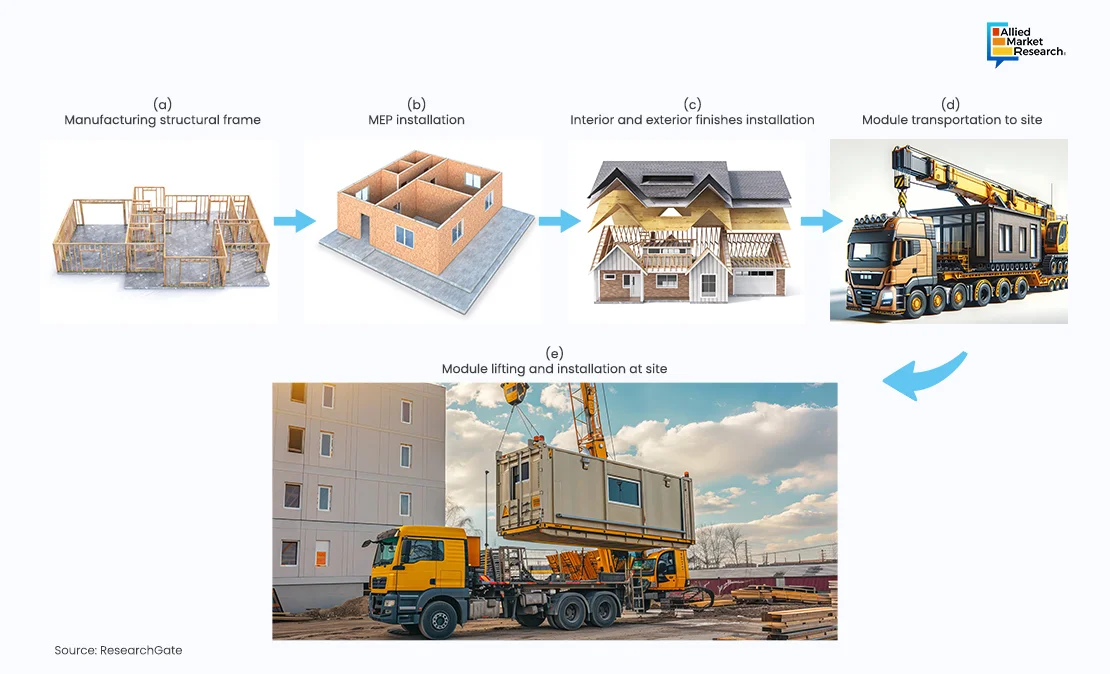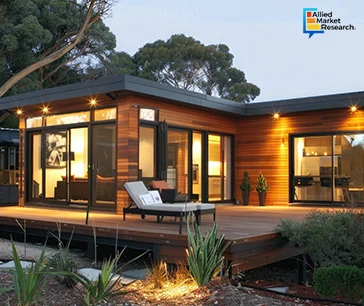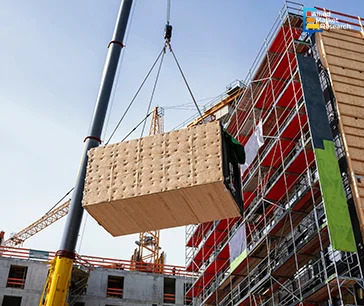Building the Future: Modular Construction Reshaping the Construction Approach

Modular construction refers to the off-site construction of modules or sections in a factory setting under controlled environments. These modules are then transported to the construction site and assembled to construct the final building. The modules are constructed using the same procedure and standards as in a traditionally built facility. A significant advantage of using construction modules is that they reduce the infrastructure construction time to almost half.
Factors such as logistical challenges, labor shortages, weather conditions, etc. often delay the construction process. Modular construction provides the best solution for such problems by reducing construction timeframes and restructuring the building process.

With increasing migration toward urban areas, especially in developing countries such as India, Indonesia, Brazil, Thailand, or Vietnam there is rise in demand for efficient & fast construction methods which meet the need for infrastructure, housing, and commercial spaces.
Breaking Ground: The Rise of Modular Construction
After 1970, modular construction technique gained enough ground among construction businesses owing to its advantages over traditional construction. Some of these advantages of modular construction included time constraints, cost-effectiveness, sustainability, flexibility, and adaptability. Modular construction gained more popularity in residential construction as it offered low-cost housing solutions to people. In subsequent years, modular construction extended into commercial constructions such as medical buildings, offices, and schools.
The integration of computer-aided design (CAD) software revolutionized the construction process of modules. The software allows architects to visualize the precise details of modules even before they are built. This technology reduces the chances of inaccuracies and human errors during module construction.

Modular Construction in the Modern Era
Over the past 40 - 50 years, the modular construction industry has grown immensely. The modular construction process has advanced over the years to offer higher quality, greater efficiency, and more intricate designs as compared to modular construction practices in the past. The real-time monitoring of tasks through sensors and automation within a controlled environment offers cost-effective & faster construction. The data collected through sensors is linked with Building Information Modeling (BIM) software, thereby elevating project management and boosting design precision. Moreover, the technology can be utilized for future maintenance and renovation projects, hence offering comprehensive lifecycle services. Moreover, usage of mobile applications is acquiring traction in the market as they allow for quality assurance and defect detection & correction. Applications such as PlanRadar allow the construction manufacturers to validate the layouts, check for the defects, and then proceed to further stages.
To reduce human error and elevate production efficiency, several manufacturers are now inclining toward robotics and automation for the construction of modules. These technologies are being deployed with AI and the Internet of Things (IoT) which significantly boost project management optimization and real-time monitoring of construction projects. Moreover, with increasing environmental concerns, reduction of carbon footprint has become a crucial objective of modular construction. Conventional construction activities consume vast amounts of timber, water, and minerals. However, modular construction involves manufacturing of building components in a factory setting with precise planning in a controlled environment. By optimizing material usage, modular construction helps conserve natural resources, lower material wastage, and reduce environmental impact. Presently, several modular construction companies invest in carbon offsetting technologies and initiatives to mitigate the carbon emissions associated with their operations. This includes investing in renewable energy projects, reforestation efforts, or carbon capture & storage technologies to offset any remaining carbon emissions generated during the construction process. For instance, in January 2024, Integra Buildings, a UK based manufacturer of modular buildings, disclosed its plans to invest approximately $1 million for reduction of carbon footprint and become a carbon neutral business by 2038. The Integra Buildings has secured environmental management standard called ISO 14001 Environmental Management as it sets out a roadmap to carbon neutrality. Similarly, in September 2022, CEMEX, a Mexico-based leading vertically integrated heavy building materials company, invested in Carbon Clean Solutions Limited. The aim of this investment was to support climate action plans and targets of the company, strengthening its obligation to lead the industry in decarbonization.

Permanent and Relocatable Construction: Serving to Diverse Demands
Modular construction presents a promising solution to contest the housing crisis as it is highly adaptable and scalable for different housing needs & budgets. The modular construction techniques accommodate various housing typologies & configurations for constructing single or multi-family apartment buildings, homes, and mixed-use developments. The modular housing projects & development of affordable, high-quality housing solutions stimulate economic growth and enhance community resilience. Construction through modular methods can be permanent or relocatable.
Permanent modular construction (PMC) involves sustainable construction of prefabricated modules which are seamlessly integrated into existing architecture with such technological details that the module becomes indistinguishable. The foundation of PMC is similar to the traditional constructions, consisting of concrete and crushed stones. Contrarily, relocatable buildings (RB) are temporary setups which provide easy access to convertible indoor spaces. Since RBs are not fixed permanently, they are installed in compliance with the guidelines of the manufacturer and local code requirements. While both construction methods offer advantages in terms of speed & efficiency, permanent modular construction often boasts faster project timelines and reduced construction durations as compared to relocatable construction. The offsite fabrication of modular components allows for concurrent site preparation and construction activities, minimizing project timelines & disruptions. Relocatable construction generally requires additional time & effort for disassembly, relocation, and reinstallation, particularly for large or complex structures. Therefore, the modular construction industry observes many permanent constructions compared to relocatable constructions.
From Factory to Site: A Rough Voyage
While the modular construction method offers a plethora of benefits, the construction of modules and adoption of this construction technique is still subjected to several limitations & challenges. Manufacturers in the market are yet to overcome these obstacles for the technique to go mainstream. One of the key challenges for the manufacturers is the hesitation and resistance among customers to switch to modular construction for their housing or commercial needs. Customers observe modular construction as a less reliable and lower quality method compared to conventional construction, hindering the widespread adoption of the modules. Extensive education and awareness regarding the benefits of modular construction techniques is necessary for the manufacturers to convince their customers regarding the usage of modules. In addition, handling and installing these modules is a skill which demands the provision of efficient training to develop a proficient labor force for installations.
The manufacturing of modules is based on predefined modules shapes and sizes as the construction technique depends on a degree of standardization for maximum efficiency and cost-effectiveness. This poses significant design constraints as customers demand unique and aesthetic structures for their buildings. 3D printing is a newly adopted technique in the modular construction market which has opened the possibilities for the manufacturing of intricate designs. This technology is a blend of benefits, including cost-effectiveness, sustainability, increased customization, and low material wastage.
Building Tomorrow with Modular Architecture
The traditional image of lengthy timelines and expansive residential construction sites is being reshaped by a promising innovation, which is modular construction. Modular construction is offering a wide range of benefits which address major challenges in the construction industry and pave its path toward a promising future. One of the important advantages is speed as modular construction significantly reduces construction timelines by manufacturing building components simultaneously with site preparation work. Moreover, modular construction offers cost efficiency by reducing on-site labor requirements, optimizing material usage, and streamlining processes. These factors are projected to boost its adoption in the coming years.
As the demand for housing continues to grow, particularly in urban areas facing housing shortages and affordability challenges, modular construction stands poised to play a pivotal role in catering to this demand. Its ability to unlock efficiency, speed, cost savings, quality, sustainability, and design flexibility positions modular construction as a transformative force in the construction industry.
Moreover, the manufacturers are making consistent efforts to deploy technology and develop innovative techniques to fast-track the construction process with improved quality offerings. The utilization of 3D printing is still at a nascent stage as only a few manufacturers are utilizing the technology for module construction. Its widespread adoption is anticipated to reshape the way architecture is built. In addition, the adoption of extended reality technologies such as augmented reality (AR) is expected to be on its way for the monitoring of the construction process. Researchers at the International Association for Automation and Robotics in Construction published a research paper which illustrated a real time 4D AR system to monitor modular construction progress. This technology makes use of the proposed AR model to compare with the as-built site, thus facilitating users to avoid possible errors by offering assembly sequence monitoring and schedule control. Therefore, as research continues and technology advances, several innovative trends will be observed in the market which will deliver versatile & promising results.
Conclusion
In conclusion, the promise of modular construction lies in its capacity to redefine the way homes are built. By unlocking unprecedented levels of efficiency, modular construction is not only reshaping the construction landscape but also offering a pathway to highly accessible, sustainable, and high-quality architecture for communities around the world. As we look to the future, modular construction represents a beacon of innovation and opportunity in the quest to address the evolving needs of homeowners and society at large.
For further insights, get in touch with AMR analysts!



